We are pleased to announce the availability of the Open Greek New Testament Bible (OGNT) this 23 August 2018. This is courtesy of Eliran Wong, the module creator (https://github.com/eliranwong/OpenGNT). The OpenGNT Project contains NA28 / NA27 Equivalent andOpen Greek New Testament Resources.
Download and usage issue: In case the default font of MySword for all text was changed to Koine Greek, please go to Preferences, tap Fonts and change the Font to Default or download another font and use that as the new Font and not the Koine Greek (MySword by default will select the first font in the fonts folder so in case you have not downloaded any font, a font in the modules with packaged font will be used).
Open Greek New Testament project aims to provide a bundle of high-quality and open-source materials on Greek New Testament for biblical studies.
An eclectic text, namely "Open Greek New Testament [OGNT]", is first produced as the base text for the rest of the project. The text of OPNT is built upon a group of high-quality scholarly materials. This aims to provide all bible students or scholars a free text, which is the closest equivalent to the text of NA28, for studies or research purposes.
This gives users a quick access to the main text of OpenGNT, keyed to Tyndale House' extended Strong's numbers and glosses, James Tauber's morphology, and variant markers on nine modern editions of Greek New Testament (i.e. B=Byzantine, I=NIV Greek, N=NA27, M=NA28 where words are different from NA27, R=Textus Receptus, S=SBLGNT, T=Tregelles's GNT, W=Westcott-Hort, H=Tydale House GNT).
Files/Modules included:
- OpenGNT.bbl.mybible - Open Greek New Testament Bible (OGNT).
Each word entry contains the following:
- accented Greek word
- Tyndale House's extended Strong's number - Dictionary is included (please see Open GNT Lexicon below)
- morphology code with lemma
- transliteration
- modern pronunciation
- English gloss
- Edition(s) [in case it's not BINRSTWH to limit the number of links] and variant(s) [if any] as Notes link (*).
Variant indicators:
- B = Byzantine
- I = NIV Greek
- N = NA27
- M = NA28 where words are different from NA27
- R = Textus Receptus
- S = SBLGNT
- T = Tregelles's GNT
- W = Westcott-Hort
- H = Tydale House GNT
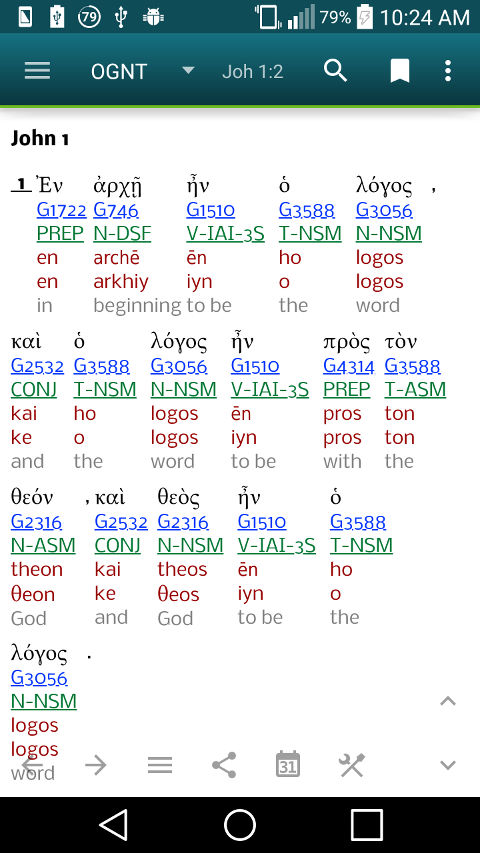
- OpenTextGNT.bbl.mybible - OpenText.org Linguisitc Annotation of the Greek New Testament Bible (OTGNT).
This contain the OpenText.org v0.11 syntax annotations that were given to Logos Bible Software when they licensed the OpenText.org annotations in 2005. Each word entry contains the following:
- Function
- w# - opens a popup that contains more information like Strong number, Morphology, Lemma, etc.
- Greek word
- English gloss
Other notations:
- Chapter:verse.word-group (e.g. 1:13.w7-w12) refers to a clause.
- @ indicates clause connection, e.g. 1:13.w7-w12@1:13.w1-w6 means 1:13.w7-w12 connects to 1:13.w1-w6.
- → indicates next (clause)
- ← indicates previous (clause)
- * indicates projected (clause)
Remarks: A helpful article is available at: http://opentext.org/resources/articles/a8.html, and section About OpenText.org Linguistic Model used for Annotation and Analysis below.
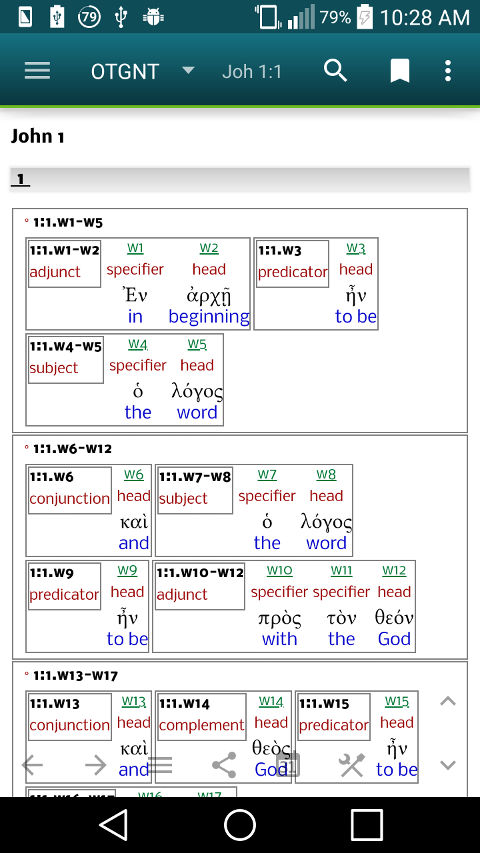
- OpenGNT-NET.bbl.mybible - Open Greek New Testament + OpenText Linguistic Annotation + Clause boundaries (blue brackets in superscript) + Phrase boundaries (red brackets in superscript) + The NET Bible® verse text (no Notes) - 2nd Edition; New Testament (OGNT-NET).
OpenText Linguistic Annotation Abbreviations:
- add - Addressee
- conj - Conjunction
- S - Subject
- P - Predicator
- C - Complement
- A - Adjunct
Other notations:
- C followed by a number (e.g. C24) refers to a numbered clause.
- → indicates clause connection, e.g. c26 → c24 means c26 connects to c24.
- * indicates projected (clause)
Remarks: A helpful article is available at: http://opentext.org/resources/articles/a8.html, and section About OpenText.org Linguistic Model used for Annotation and Analysis below.
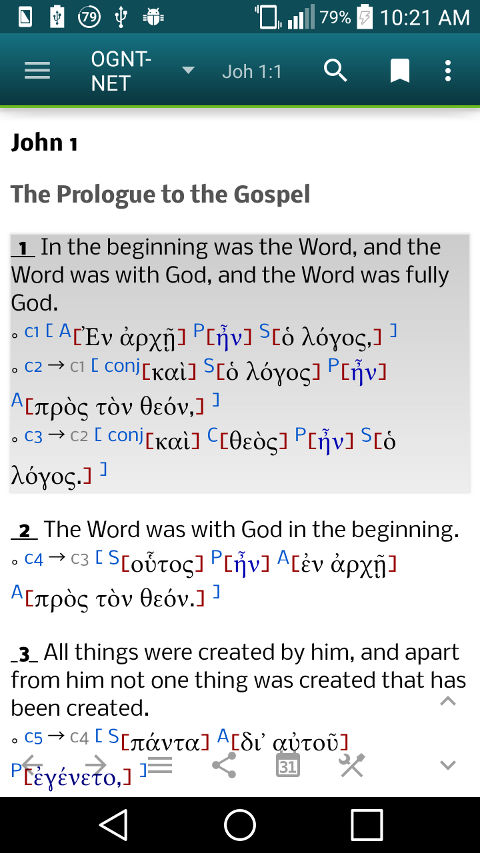
- OpenGNTi.bbl.mybible - Open Greek New Testament (Inline Interlinear Tyndale House's glosses w/ variants); sub-meanings of pronouns worked out by Eliran Wong (OGNTi).
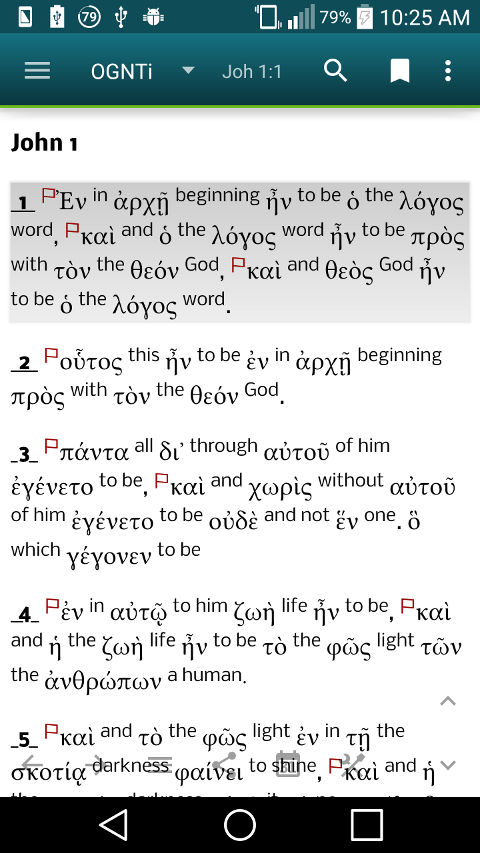
- OpenGNTii.bbl.mybible - Open Greek New Testament (Inline Interlinear Tyndale House's glosses w/ variants + Tyndale House's extended Strong's numbers + James Tauber's morphology) (OGNTii).
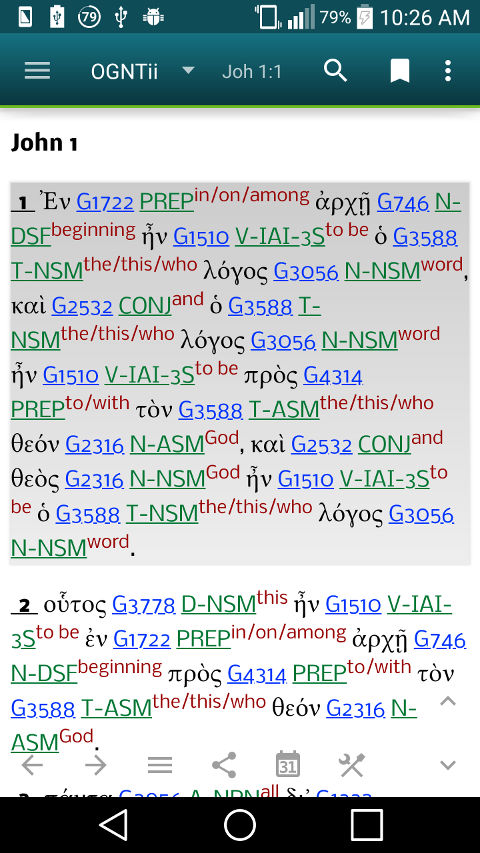
- OpenGNTk.bbl.mybible - Open Greek New Testament formatted in Koine Greek (OGNTk). Created for the purpose of searching and for advanced users who read ancient manuscript. Formatted in Koine Greek: The lunate sigma “C” is used as in early New Testament manuscripts, instead of the miniscule sigma “σ” and terminal sigma “ς” used since the Middle Ages.
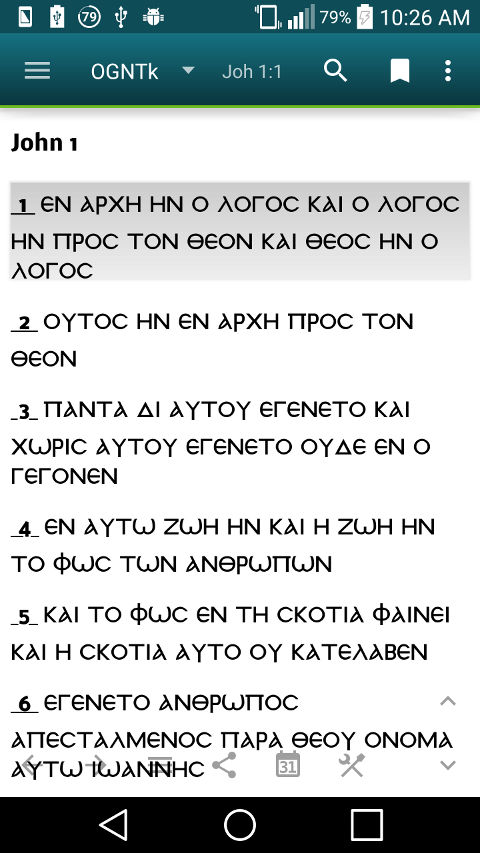
- OpenGNTd.bbl.mybible - Open Greek New Testament (w/ inline commentary of Levinsohn's GNTDF + Levinsohn's clause division + textual variants) (OGNTd).
- Clause division is represented by a line break, with each clause starts with a symbol °.
- Inline commentary of Levinsohn's GNTDF is represented by note marked with "R1, R2, R3, etc."
- Text variants are represented by note marked with "N1, N2, N3, etc."
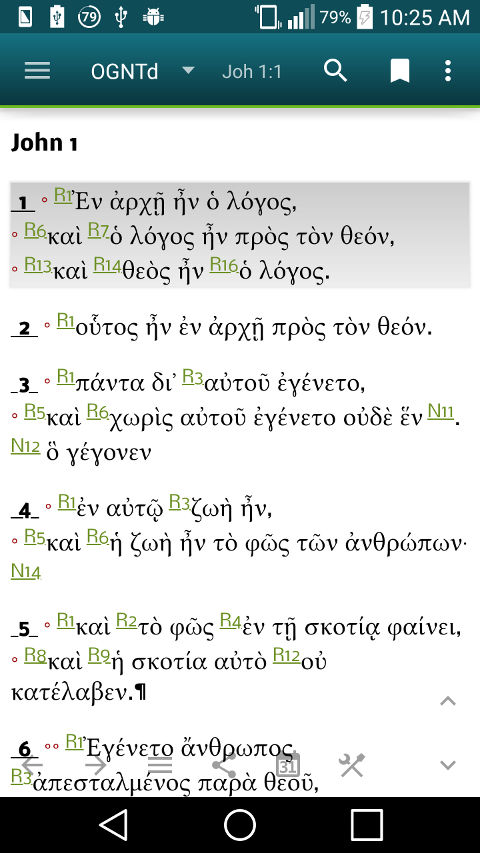
- OpenGNTLexicon.dct.mybible - An Analytical Lexicon on Open Greek New Testament + Tyndale Brief lexicon of Extended Strongs for Greek (OGNT).
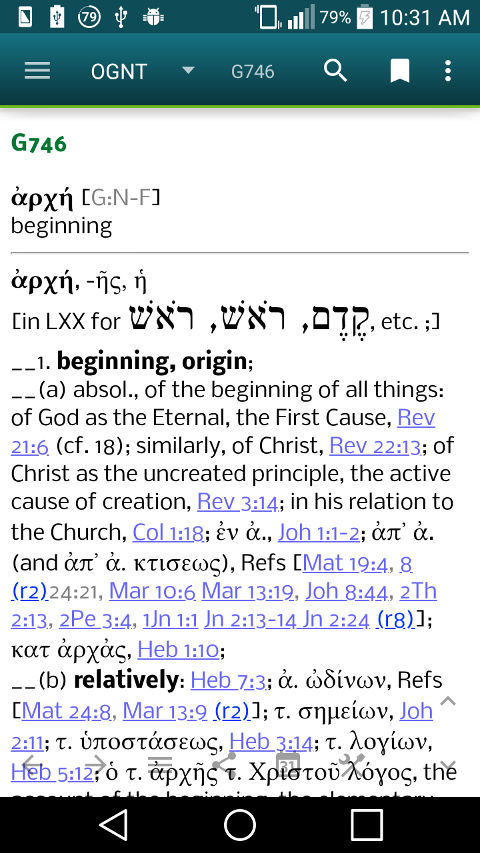
- OpenGNTRMAC.dct.mybible - Robinson's Morphological Analysis Codes Dictionary (OGNTRMAC). This is an enhanced version of RMAC dictionary for description on morphological codes. Please note that it will not replace the official MySword RMAC dictionary, which has only 1100 entries. Eliran Wong fixed wrong entries found in the original one, reformatted and added an extra of 289 entries in this enhanced version.
License:
All files produced by this project are released under CC BY-NC-ND 4.0 with additional specified relaxations
You are allowed to use or distribute OpenGNT materials for non-commercial purpose (formatting is allowed, without changes in mapping data).
You are required to quote the following information, when any parts of OpenGNT materials are integrated in your own work or distributed:
Open Greek New Testament Project
Developer: Eliran Wong [Contact; BibleBento.com],
Source at https://github.com/eliranwong/OpenGNT/
[Remarks: Please include all links available in the credit information above.]
Other Credits:
TANTT data:
"Tyndale House, Cambridge" [www.TyndaleHouse.com],
and "STEP Bible" [www.STEPBible.org]
and source at tyndale.github.io/STEPBible-Data/
The OpenText.org Syntactically Annotated Greek New Testament
Stanley E. Porter
Matthew Brook O'Donnell
Jeffrey T. Reed
Source: GNT Annotation (version 1.0)
This annotation was completed in 2006 and was made available for viewing on the OpenText.org website and also implemented in Logos bible search software.
The annotation data has been migrated to a new, inline XML format by Christopher Land and the base text has been corrected and updated to the NA28 by Christopher Land and Ryder Wishart.
Levinsohn's Greek New Testament Discourse Features
Stephen Levinsohn's complete discourse features markup of the Greek New Testament (UBS4/NA27). This data was originally developed in BART and follow principles Levinsohn documented in his volume of Discourse Features of New Testament Greek.
Source: https://github.com/biblicalhumanities/levinsohn
©2016 SIL International
License
Released by:
Paul O'Rear
Associate Coordinator
International Translation
SIL International
NET Bible Copyright 2nd Edition (2017)
NET BIble® Copyright THE NET BIBLE®, New English Translation (NET) Scripture quoted by permission. Quotations designated (NET) are from the NET Bible® copyright ©1996-2016 by Biblical Studies Press, L.L.C. http://netbible.com All rights reserved. The names: THE NET BIBLE®, NEW ENGLISH TRANSLATION COPYRIGHT (c) 1996 BY BIBLICAL STUDIES PRESS, L.L.C. NET Bible® IS A REGISTERED TRADEMARK THE NET BIBLE® LOGO, SERVICE MARK COPYRIGHT (c) 1997 BY BIBLICAL STUDIES PRESS, L.L.C. ALL RIGHTS RESERVEDSATELLITE IMAGERY COPYRIGHT (c) RØHR PRODUCTIONS LTD. AND CENTRE NATIONAL D'ÉTUDES SPATIALES PHOTOGRAPHS COPYRIGHT (c) RØHR PRODUCTIONS LTD.
The NET Bible® verse text (no Notes) can be used by anyone and integrated into your non-commercial project or publication upon condition of proper Biblical Studies Press copyright and organizational acknowledgments ... (http://netbible.com/net-bible-copyright)
Morphological Lexicon of the Greek New Testament
Source: https://github.com/morphgnt/morphological-lexicon
It is used to process data for mapping purpose.
Sources:
The base text of OpenGNT project, OGNT in short, is largely developed from a scholarly database, "TANTT - Tyndale Amalgamated NT Tagged texts".
Read in folder "From_TANTT_to_OpenGNT" for an introduction of TANTT and additional content, introduced by OpenGNT.
Comparison between OGNT & NA28:
OGNT is checked against NA28, verse by verse and word by word. Below are some of the observations:
Resemblance:
- SAME number of verse
- SAME versification (Remarks: Shorter ending of Mark 16 is placed at the end of Mark 16:20, enclosed by a pair of brackets.)
- SAME number of words
- SAME spelling for every word
- SAME word order
Differences:
- NA28 is published by German Bible Society, whereas the text of OGNT is based on TANTT, produced by Tyndale House Cambridge UK from an open source.
- NA28 is copyrighted; OGNT is released under a free-license.
- different divisions on paragraphs are noted occasionally.
- OGNT / TANTT does not have special formatting on poetic lines, as found in NA28.
- OT quotations in OGNT are marked according to an open resource avaialble at https://github.com/biblicalhumanities/levinsohn/blob/master/LGNTDF/OT_quotes.xml.
- different use of punctuations are observed in various places. (The most common difference noted is that OGNT / TANTT uses "·" in various places whereas NA28 uses ".".)
- variants are presented differently. OGNT / TANTT presents variants from modern GNT editions only. In addition, OGNT / TANTT, in most cases, does not include variants where the text of NA omits. In terms of variant readings NA28 covers better and give readings of early manuscripts not modern GNT editions.
- 3006 words are different in capitalisation (a list of differences is provided in this folder, only words from OGNT is included, words from NA28 are excluded here due to copyright issue)
- 421 words are different in accents (a list of differences is provided in this folder, only words from OGNT is included, words from NA28 are excluded here due to copyright issue)
- The text of OGNT is keyed to Tyndale's House's extended Strong's numbers, James Tauber's morphology and mapped to various features, through which users can have quick access to lexicons and linguistic features, etc.
About OpenText.org Linguistic Model used for Annotation and Analysis
Introduction to the Annotation Model
The clause is recognized as the primary building block in the OpenText.org annotation model because it is the level at which propositions are made. The different types of annotations are thus built around the clause annotation, the word group annotation (which make up the clause components), and the relationship between clauses (including the distinction into distinct primary, secondary, and secondary embedded clause levels) as the base. Table 1 summarizes the major categories of tags for the clause and word group level annotations. The vertical axis of the table delineates the four basic clause level function slots. The horizontal axis of the table gives the three clauses levels. The information within the table refers to the word groups, which fit inside the clause function slots.
| Clause Level | Subject (S) | Predicator (P) | Complement (C) | Adjunct (A) |
|---|---|---|---|---|
| Primary | Head Term-Modifiers | Verbal Form | Head Term-Modifiers | Head Term-Modifiers |
| Secondary Unembedded | Head Term-Modifiers | Verbal Form | Head Term-Modifiers | Head Term-Modifiers |
| Secondary Embedded | Head Term-Modifiers | Verbal Form | Head Term-Modifiers | Head Term-Modifiers |
Clause Level Annotation
At the clause level, only four tags are used, excluding conjunctions between clauses (marked “conj”). To aid understanding, it is helpful to consider the clause functions in terms of function slots. All word groups fit into these function slots. There are only four function slots and they are:
- Subject (S)
- Predicator (P)
- Complement (C)
- Adjunct (A)
The tag subject (S) is used of a word group or the word groups of which something is predicated. (In traditional grammar the distinguishing term is “grammatical subject.”)
All verbal forms are tagged as predicators (P).
A complement (C) is a word group or the word groups that “complete” its predicator. Common complements are direct and indirect objects.
An adjunct (A) is a word group or the word groups that modify the predicator, providing an indication of the circumstances associated with the process. Common adjuncts are prepositional and adverbial phrases.
This annotation scheme reflects Halliday’s conception of the grammar of a clause (i.e., the transitivity system at the level of a clause). The subjects and complements in the clause level annotation correspond to the participants in a process; the predicators correspond to the processes; and the adjuncts typically correspond to the circumstances associated with the process, though some adjuncts are peripheral participants in a process.
Word Group Level Annotation Model
At the word group level, all words are basically either head terms or modifiers. The head term usually refers to the nominal that all the other words in the word group modify. Four types of modifiers are identified:
- specifiers (sp)
- definers (df)
- qualifiers (ql)
- relators (rl)
A specifier (sp) is a modifier that classifies or identifies the word it modifies. Common examples of specifiers are articles and prepositions.
A definer (df) is a modifier that attributes features or further defines the word it modifies. Common examples of definers are adjectives (both attributive and predicate structure) and appositional words or phrases.
A qualifier (ql) is a modifier that in some way limits or constrains the scope of the word it modifies. Common examples of qualifiers are words in the genitive and dative case.
A relator (rl) is a word specified by a preposition (i.e., the object of a preposition) that modifies another element within the word group.
Clause Levels
Clauses are divided into two levels: (1) primary clauses; and (2) secondary clauses. The primary and secondary distinction has to do with the two possible types of logical dependency, dependence (hypotaxis) or equality (parataxis). Primary clauses are connected to each other, while secondary clauses are connected to the primary clause to which it is dependent. The majority of primary clauses consist of clauses with a finite verb. Secondary clauses are typically distinguished by means of a subordinating conjunction. A second type of secondary clause, the embedded clause, involves the phenomenon of rank-shifting—a linguistic element is embedded to a level of grammar lower than the typical level at which it functions. The majority of secondary embedded clauses in Greek are participial and infinitival clauses.
Symbols used for clause levels in OGNT-NET and OTGNT:
° - Primary
°° - Secondary
°°° - Embedded
Clause connections
Alongside the three levels of clause distinguished in the OpenText.org clause annotation is the concept of clause connection. Each clause is marked with a connect value which indicates the clause within the surrounding discourse to which it is most immediately relates. In the diagram below, this value is indicated at the beginning of each clause underneath the clause identifier.
Romans 1:13 OGNT-NET I do not want you to be unaware, brothers and sisters, that I often intended to come to you (and was prevented until now), so that I may have some fruit even among you, just as I already have among the rest of the Gentiles.
° c24 → c18 [ A[οὐ] P[θέλω] conj[δὲ] C[ὑμᾶς]C[ c25 [ P[ἀγνοεῖν,] ]] add[ἀδελφοί,] ]
°° c26 → c24 [ conj[ὅτι] A[πολλάκις]P[προεθέμην] C[ c27 [ P[ἐλθεῖν] A[πρὸς ὑμᾶς,] ]] ]
°° c28 → c26 [ conj[καὶ] P[ἐκωλύθην] A[ἄχρι τοῦ δεῦρο,] ]
°°° c29 → c26 [ conj[ἵνα] C[τινὰ καρπὸν]P[σχῶ] conj[καὶ] A[ἐν ὑμῖν] ]
°°° c30 → c29 [ conj[καθὼς] conj[καὶ] A[ἐν τοῖς λοιποῖς ἔθνεσιν.] ]
OTGNT
subject
head
Παῦλος
Paul
definer
head
δοῦλος
a slave
qualifier
head
Χριστοῦ
of Christ
definer
Ἰησοῦ
Jesus
definer
κλητὸς
called
head
ἀπόστολος
an apostle
predicator
head
ἀφωρισμένος
being separated
adjunct
specifier
εἰς
for
head
εὐαγγέλιον
gospel
qualifier
θεοῦ
of God
So clause Rom.c1_26 connects to Rom.c1_24 (c26 → c24; 1:13.w7-w12@1:13.w1-w6). Rom.c1_26 is a secondary clause connected to a primary clause, so it is indented and said to depend on Rom.c1_24. The next non-embedded clause, Rom.c1_28 is also a secondary clause and it connects back to Rom.c1_26. However, it has been analyzed in a coordinate relationship (connected by καὶ) and so is not indented. In contrast, the following clause, Rom.c1_29, is subordinate to the clause it connects with (Rom.c1_26) and is therefore displayed with a further level of indentation.
